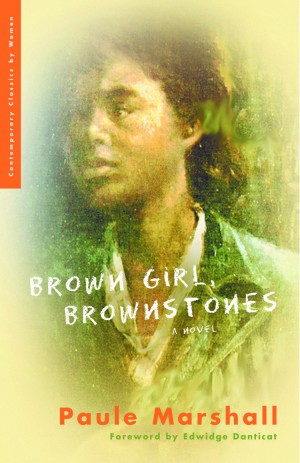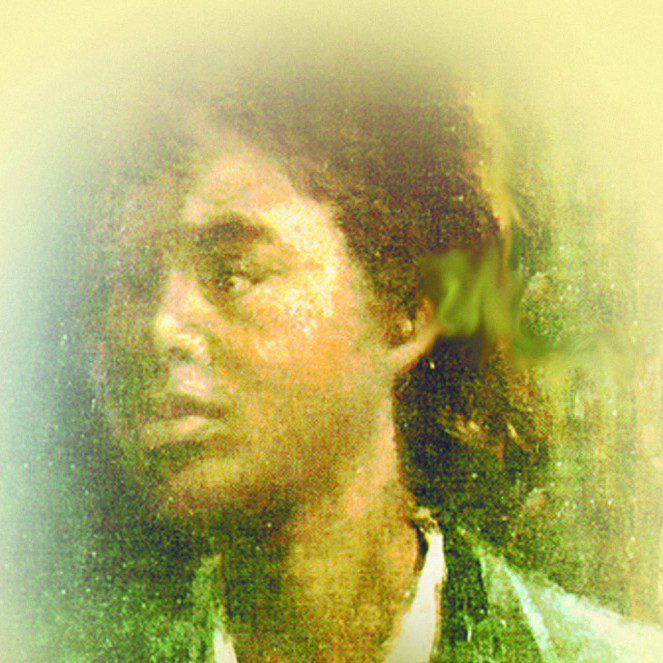My dreams, for so long unrestrained by land, air, or even death—and frequently including scenes of me tumbling through the air on glossy black feathered wings or jumping into an abyss with a smile on my face—now generally take place in a building with four walls and a roof. I dream of houses. I dream of owning a home, post-Great Recession, and despite the weight of federal student loans on my back. I am frequently visited by visions of curtains that open up to reveal a cold sunlight in the morning, of a cubbyhole library, perhaps in the attic, and of backyards that lend themselves to Slip ‘n Slides and crisp autumnal leaf piles. I would dream of brownstones, except I’m in the wrong tax bracket. Crippling pragmatism happens sometimes.
Occasionally, after these fantasies, I return to Paule Marshall’s Brown Girl, Brownstones, originally published in 1959 by Random House. As with many books, my allegiances to certain characters evolve over time and with age. As a teenager, Beneatha Younger from Lorraine Hansberry’s A Raisin in the Sun was my afro-haired spirit animal, always being smacked down (literally) by the elders in her life for her spunk and willingness to redefine her place as a black woman in America and in her family, always questioning and never satisfied. Just before I turned 30, and after a couple of failed relationships with men who had ill-defined or nonexistent ambitions, my allegiances turned to Beneatha’s sister-in-law, Ruth Younger. Ruth, who did so much and asked for so little, who faced economic realities that caused her to consider an abortion while her husband was waxing poetic about liquor stores.
In Brown Girl, Brownstones, which I read two years ago, I started out heavily involved with and invested in the protagonist, Selina Boyce—a second generation Bajan-American living in Brooklyn—and have lately embraced Selina’s mother, Silla, who is similar to my own mother and her American dream-centered ambitions. A South Side Chicago girl (Chatham to be precise) with college-educated parents, my mother gave directives to her female offspring that were very clear: get good grades, do a stint in Jack and Jill, go to college, avoid out-of-wedlock births, procure a good job and, perhaps later, a husband and children. In that exact order.
 Selina is given similar instructions from her mother, who dreams of owning a Brooklyn brownstone: join the Barbadian church group, get good grades, become a doctor, meet an “acceptable” guy—a member of the community—and buy a brownstone. In that exact order. Though the story focuses on Selina’s coming of age in terms of her ethnicity, class, and sexuality (it is no accident that subsequent editions of the book were published by The Feminist Press at the City University of New York), it is Silla’s dreams of owning a brownstone that haunt me.
Selina is given similar instructions from her mother, who dreams of owning a Brooklyn brownstone: join the Barbadian church group, get good grades, become a doctor, meet an “acceptable” guy—a member of the community—and buy a brownstone. In that exact order. Though the story focuses on Selina’s coming of age in terms of her ethnicity, class, and sexuality (it is no accident that subsequent editions of the book were published by The Feminist Press at the City University of New York), it is Silla’s dreams of owning a brownstone that haunt me.
This is not to say that Selina’s struggle is any less compelling. Her teenage rebellion, culminating in a dramatic outburst intent on embarrassing her mother, struck a note in me, as I pulled a similarly childish stunt during a Jack and Jill conference while in high school. How clever I thought I was, railing against bougie pretensions in that petulant teenage pitch (you know the one). Yet in my thirties, I find myself comparing my life to my mother’s at this same age, understanding what she wanted of me and desiring it on my own. Career. Husband. Children. House. In that order. A yard built for raising a family and upon one can look out on from behind the aforementioned curtains, watching the world go by.
Silla is portrayed as cruel and oppressive, unyielding. Her children fear her; her husband Deighton spites her. “For always the mother’s voice was a net flung wide, ensnaring all within its reach,” Marshall writes. Through Selina’s eyes, Silla is like a chapter from the Book of Ruth, Hansberry edition, without the empathy. Yet, as a 30-something woman, I can understand how she might have turned so bitter, so angry, raising three children in poverty while her husband pursued whims like being a trumpet player, an accountant, a radio repairman, or a car mechanic with the unrealistic fervor reserved for buying lotto tickets, and leaving Silla to be the main financial contributor. She earns her family’s money as a domestic, dealing with subtle and aggressive racism all day long while working on her knees. Her desire to own four walls and a roof are simple in comparison. The brutal way Silla and Deighton wreck each other midway through the book, I see years later, as a commentary on how easily the American dream and capitalism can corrupt even the most earnest desires.
Reading the contrasts between Selina and Silla reminds me of a stretch of time in my twenties. It’s a period in which you feel smugly certain that your life is vastly different from your mother’s. You don’t imagine that your mother fell in love with inappropriate men and had sex just because she liked a guy’s dimples. You don’t imagine that your mom wanted to take off and live in another city to live a grand adventure, or explored bohemian scenes, or lived selfishly, or did only things to please herself—sleeping until noon, smoking, or leaving work early. So you do those things with gusto and abandon, but before you know it, you are speaking to a child in the same way your mother spoke to you, or giving your boss the same look your mom gave you when she knew you were lying.
At a critical point in Brown Girl, Brownstones, Selina makes peace with the ways she is like her mother, in a quietly devastating way.
“Everybody used to call me Deighton’s Selina but they were wrong. Because you see I’m truly your child. Remember how you used to talk about how you left home and came here alone as a girl of eighteen and was your own woman? I used to love hearing that. And that’s what I want. I want it!
Silla’s pained eyes searched her adamant face, and after a long time a wistfulness softened her mouth. It was as if she somehow glimpsed in Selina the girl she had always been.”
The summer I read this book, I made a similar peace with my mother. I began calling and Skyping home more, trying to bridge a physical distance of more than 900 miles. On holidays, we’re hugging more, and listening. I’ve inherited her voice and wry mannerisms. I’ve fulfilled some of both of our desires, but also understand more about her extremely rich experiences. I imagine that a Brown Girl, Brownstones sequel would show Selina, back in Brooklyn after her excursion to Barbados, shaking her head knowingly at a young, Angela Davis-crowned version of herself. She would probably tell her to mind the bohemians and beware of men with idle hearts and hands. The daughter will pursue her own dreams, evolving over time, just as her mother once also did.
***
This is part of an ongoing series, produced in partnership with Tumblr Storyboard, to highlight Tumblr writers (and the books they love). Want to have your essay considered? Submit it here. We’ll publish our favorites every Friday for the next seven weeks.





One response
Thank you so much for such an insightful parallel! I am a sophomore in college, and initially came across your post while searching for summaries of Brown Girl, Brownstones. However, we (coincidentally) read A Raisin in the Sun a few week ago, and I also felt such a blatant connection to Beneatha! I think the realization that your outlook has changed from a youthful and fearless Selina/Beneatha to the more responsible Silla/Ruth is one of genius. As a woman grows older and more mature, she has to shed a bit of that headstrong attitude and take responsibility for her environment and future, just as Silla and Ruth both have as characters in their respective works.
I hope you don’t mind me borrowing the idea for a required discussion post on Brown Girl, Brownstones. I am truly and thoroughly impacted by your ideas, thank you so much for sharing.
Click here to subscribe today and leave your comment.